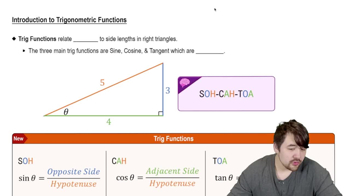Table of contents
- 0. Functions7h 52m
- Introduction to Functions16m
- Piecewise Functions10m
- Properties of Functions9m
- Common Functions1h 8m
- Transformations5m
- Combining Functions27m
- Exponent rules32m
- Exponential Functions28m
- Logarithmic Functions24m
- Properties of Logarithms34m
- Exponential & Logarithmic Equations35m
- Introduction to Trigonometric Functions38m
- Graphs of Trigonometric Functions44m
- Trigonometric Identities47m
- Inverse Trigonometric Functions48m
- 1. Limits and Continuity2h 2m
- 2. Intro to Derivatives1h 33m
- 3. Techniques of Differentiation3h 18m
- 4. Applications of Derivatives2h 38m
- 5. Graphical Applications of Derivatives6h 2m
- 6. Derivatives of Inverse, Exponential, & Logarithmic Functions2h 37m
- 7. Antiderivatives & Indefinite Integrals1h 26m
- 8. Definite Integrals4h 44m
- 9. Graphical Applications of Integrals2h 27m
- 10. Physics Applications of Integrals 2h 22m
6. Derivatives of Inverse, Exponential, & Logarithmic Functions
Derivatives of Inverse Trigonometric Functions
Problem 3.10.51
Textbook Question
47–56. Derivatives of inverse functions at a point Consider the following functions. In each case, without finding the inverse, evaluate the derivative of the inverse at the given point.
f(x)=tan x; (1,π/4)
 Verified step by step guidance
Verified step by step guidance1
Identify the function given: \( f(x) = \tan x \). We need to find the derivative of its inverse at the point \((1, \pi/4)\).
Recall that if \( y = f^{-1}(x) \), then \( f(y) = x \). The derivative of the inverse function at a point \( x = a \) is given by \( (f^{-1})'(a) = \frac{1}{f'(f^{-1}(a))} \).
Since \( f(x) = \tan x \), the derivative \( f'(x) = \sec^2 x \).
We know \( f(\pi/4) = \tan(\pi/4) = 1 \), so \( f^{-1}(1) = \pi/4 \).
Substitute \( f^{-1}(1) = \pi/4 \) into the formula for the derivative of the inverse: \( (f^{-1})'(1) = \frac{1}{f'(\pi/4)} = \frac{1}{\sec^2(\pi/4)} \).
 Verified video answer for a similar problem:
Verified video answer for a similar problem:This video solution was recommended by our tutors as helpful for the problem above
Video duration:
4mPlay a video:
Was this helpful?
Key Concepts
Here are the essential concepts you must grasp in order to answer the question correctly.
Inverse Functions
Inverse functions are functions that 'reverse' the effect of the original function. If f(x) takes an input x and produces an output y, then the inverse function f⁻¹(y) takes y back to x. Understanding how to find and work with inverse functions is crucial for evaluating derivatives of inverses.
Recommended video:

Inverse Cosine
Derivative of Inverse Functions
The derivative of an inverse function can be calculated using the formula (f⁻¹)'(y) = 1 / f'(x), where y = f(x). This relationship shows that the slope of the tangent line to the inverse function at a point is the reciprocal of the slope of the tangent line to the original function at the corresponding point.
Recommended video:

Derivatives of Inverse Sine & Inverse Cosine
Trigonometric Functions and Their Derivatives
Trigonometric functions, such as f(x) = tan(x), have specific derivatives that are essential for solving problems involving these functions. For example, the derivative of tan(x) is sec²(x). Knowing these derivatives allows for the application of the inverse derivative formula effectively in the context of trigonometric functions.
Recommended video:

Introduction to Trigonometric Functions

 7:26m
7:26mWatch next
Master Derivatives of Inverse Sine & Inverse Cosine with a bite sized video explanation from Callie
Start learning


